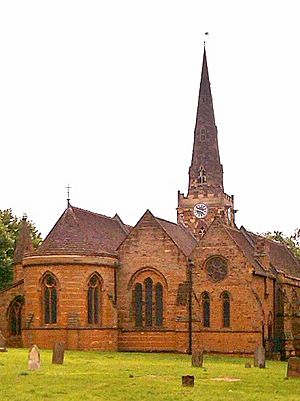The Holy Sepulchre, Northampton facts for kids
The Holy Sepulchre is a very old church in Northampton, England. It's special because it's a round church, built around the year 1100. This church is a Grade I listed building, which means it's super important historically and architecturally. It might have been built by a powerful person named Simon de Senlis, who was the Earl of Northampton.
There are only four medieval round churches still used in England today. The others are the Holy Sepulchre, Cambridge, the Temple Church in London, and St John the Baptist in Little Maplestead, Essex. A group called The Church of the Holy Sepulchre (Northampton) Restoration Trust was started in 1982 to help take care of and restore the church.
Why Was It Built?
Simon de Senlis, the Earl of Northampton, was important for making Northampton a strong Norman town. He built Northampton Castle (which is gone now) and a town wall. He probably also built the All Hallows Church and the Holy Sepulchre church.
Around 1096, Simon de Senlis went on the First Crusade to the Holy Land. While there, he would have seen the famous Church of the Holy Sepulchre in Jerusalem. This church was also round, with columns and a walkway around the edge. It was believed to be the site of Christ's tomb. This Jerusalem church was a restored version of an even older church built in the 4th century by Constantine I.
It's thought that after Simon de Senlis returned to Northampton, he built the "Holy Sepulchre" around 1100. It's about half the size of the church in Jerusalem. The first church in Northampton had a round main area with eight columns. It also had a walkway around the outside. Some old windows suggest it had a special area for the altar, called a chancel, at the east end.
Later, more parts were added to the church. A north aisle was built around 1180, and another north aisle was added around 1275. In the early 1400s, a south aisle was built. The upper part of the round main area was changed to have more windows, and a tower was added to the west side.
How Was It Built?
People kept going on Crusades and pilgrimages to the Holy Land. This led to more round churches being built in England. About 30 years after the Holy Sepulchre in Northampton was built, a similar Holy Sepulchre church was built in Cambridge. Even though the Cambridge church is smaller, it might give us clues about how the original Northampton church looked.
The Cambridge Round Church has a round-arched doorway at the west entrance. The Northampton church might have had a similar entrance. The south porch we see today was added much later. When you go inside the Cambridge church, it also has eight large round pillars. Unlike the Northampton church, the walkway around the pillars in Cambridge has a vaulted ceiling and a gallery above it. The pillars support round arches, and there's a lot of zig-zag decoration typical of Norman style.
At the Holy Sepulchre in Northampton, three original Norman windows still exist. One is low on the south side, and two are high on the north side. Having windows at different levels suggests there was once a gallery, like in Cambridge. There's also evidence of a stone ledge that ran around the edge, supporting this idea. However, unlike Cambridge, there are no signs of how the ceiling might have been vaulted. The pillars in Northampton now support pointed arches, which are from a later style than the original Norman round arches.
The Cambridge church has a cone-shaped stone roof. When it was restored in the 1800s, people tried to make it look like the original Norman design. The Holy Sepulchre in Northampton currently has a flatter lead roof. It's likely that its original roof was also cone-shaped, similar to the one in Cambridge.
Changes Over Time
Over the years, a main hall (nave), an altar area (chancel), and side sections (aisles) were added to the east of the round church in Northampton. In the 1800s, a famous architect named Sir George Gilbert Scott did a lot of restoration work to bring the church to its current look. The screen in front of the chancel was made by John Oldrid Scott in 1880.
See also
- Grade I listed buildings in Northamptonshire
- List of churches in Northampton
Images for kids




